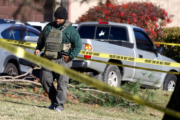JERUSALEM — A glass display case in Jerusalem’s Bible Lands Museum contains a clay pitcher, whose ancient crumbling surface reveals a colorful depiction of a bird. Nearby is a double-headed clay figurine and a tile painted with an image of a woman.
Thought to be about 3,000 years old, the items in the new “Finds Gone Astray” exhibit are among about 40,000 objects that Israeli officials have confiscated from antiquities smugglers and looters of archaeological sites in the contested West Bank during the past 50 years. They are being put on display for the first time, an unusual move for the museum, which like most others does not display stolen items.
[MORE: Countries Seen as Offering the Greatest Heritage]
“As a museum I believe it was not only our responsibility to display these objects, but it’s our moral duty,” says the museum’s deputy director, Leora Berry. The exhibit, a joint project with the Defense Ministry, aims to raise awareness about the widespread theft and smuggling of antiquities in the West Bank, says Berry, and how the trade threatens the preservation of cultural heritage.
But with an opening ceremony in late December that included speeches about the importance of Israel’s continuing control of the West Bank, and questions emerging about the ethics and legality of displaying the confiscated objects, the exhibit also offers a window into the growing role that archaeology is playing in the Israeli-Palestinian conflict.
In recent years, new exhibits, archaeological parks and excavations have become vehicles for both Israelis and Palestinians to stake physical claims and emphasize their historic connections to the long-disputed land between the Jordan River and the Mediterranean Sea.
“The government of Israel realizes that archaeology is a very effective tool to justify the Israeli settlements in the West Bank and take over more land,” says Yonatan Mizrachi, an archaeologist and spokesperson for the Israeli nongovernmental organization Emek Shaveh, which promotes cultural heritage as a public asset for all. “And, unfortunately, sometimes we see the Palestinians using the same methods, to a lesser extent. And these methods don’t help anyone.”
Palestinian officials point to the practice as violating the Hague Convention for the Protection of Cultural Property in the Event of Armed Conflict, which bans taking artifacts out of occupied territory.
[MORE: The 25 Best Countries in the World]
“It is illegal; the Israelis need to give these things back to the Palestinians instead of putting them in an exhibition,” says Jehad Yasin, general director of excavations and museums for the Palestinian Authority, which has some jurisdiction over a noncontiguous area that makes up the remaining 40 percent of the West Bank, a region containing villages, cities like Jericho and Ramallah, and about 1,200 known archaeology sites. “This exhibit just encourages more looting.”
Governments infusing nationalist politics into archaeology isn’t new. In China, for example, contemporary archaeology is being used to prove that civilization first began in the ethnic Han Chinese plains of the country’s east and spread west to Tibet and Xinjiang, areas populated by other ethnic groups and the source of modern unrest. The Jerusalem museum’s exhibit, however, is putting a new focus on the disputed West Bank, drawing public attention to Israel’s complicated and controversial role in archaeology in a place where relations between governments are brittle.
Until recently, the dozen artifacts in the “Finds Gone Astray” exhibit were among tens of thousands of stolen, smuggled and locally excavated ancient objects sitting in limbo in Israeli military warehouses in the West Bank. Israel conquered the West Bank from Jordan in the 1967 Six Day War, and following the Oslo Accords of the 1990s now maintains control over about 60 percent of the land, including more than 2,600 identified archaeological sites.
That control was supposed to be a temporary arrangement until more of this land — and any artifacts found in it — would be turned over to the Palestinians for an independent state. But with the peace process stalled, the Civil Administration department of Israel’s Defense Ministry still oversees the area. That control includes overseeing all archaeology in the Israeli-controlled areas of the West Bank, from granting excavation permits to fighting illegal digging and smuggling of artifacts. In the process, Israel has built up a massive collection of both excavated and confiscated antiquities, whose contents remain a military secret.
“It is my duty to protect these sites and these antiquities,” says Hananya Hizmi, staff officer for archaeology in the Civil Administration.
Gideon Avni, head of the archaeological division at the Israel Antiquities Authority, which oversees excavations inside Israel, says he also is concerned about the ethics of displaying such items, some of which were smuggled from Iraq and Syria. Objects with an unknown provenance rarely have scientific value, he says.
“As a rule we don’t encourage exhibition of looted objects.”
In the West Bank, most looters are Palestinians, and most cases happen at remote sites in Israeli-controlled areas, according to Yasin and Israeli officials. With Israel being one of the only countries in the region that allows the buying and selling of antiquities, there is a ready market for such items, says Avni, who adds that the Antiquities Authority has been lobbying the government for at least 30 years to restrict artifact trade in hope that will discourage looting of sites.
Yasin says that Israel benefits from the looting because when objects are confiscated in Israeli-controlled areas, where the Palestinian Authority has no jurisdiction, it is the Israeli government that takes possession of the items.
Meanwhile, Israeli government officials at the exhibit’s opening ceremony said fighting the looting in the West Bank is a priority, and accused Palestinian looters of deliberately trying to erase signs of Jewish history there.
“Every day that we don’t guard Judea and Samaria, people steal and people clean our sites of treasures in order to cut us off from our land,” says Israel’s deputy minister of defense, Eliyahu Michael Ben-Dahan, using the Biblical Hebrew terms for the land that comprises the West Bank.
The museum says it’s only borrowing the artifacts, and that scholars have already gained from the collection, publishing articles in an accompanying catalogue.
[MORE: The 10 Countries Seen as the Most Religious]
“The museum is not saying that this belongs to us,” says Berry, the museum’s deputy director. “It’s not about belonging or owning, it’s about documenting.”
But in this disputed slice of land that has been home to some of history’s most significant civilizations for thousands of years, archaeology always has the potential to be associated and used for competing claims to ownership, archaeologists say.
In Hebron, a West Bank city where hundreds of Israeli Jews live in an enclave surrounded by thousands of Palestinians, Israel recently opened a new national park to showcase 2,000-year-old ruins of ritual baths and a wine press, typical signs of ancient Jewish life, uncovered during excavations in 2014. For Hebron’s Jewish community, which lives in what most of the world considers an illegal settlement established following the Six Day War, this archaeological discovery was welcomed as new evidence of the city’s Jewish history and added to their legitimacy of living there.
“Now it’s obvious that this was a Jewish town,” says Noam Arnon, a spokesman for the Jewish community in Hebron. The city is home to the Tomb of the Patriarchs, a shrine holy to Jews and Muslims, both who believe it to be built above a series of caves that are the burial place of the Bible’s Abraham, Isaac and Jacob and their wives. “This also means that the tomb was originally a Jewish holy place,” Arnon says.
But Palestinian residents have criticized the park, saying it only highlights a small part of the city’s long history, and is located on their land.
“This should be part of Palestinian history, but it’s under occupation,” Yasin says. “It’s being used in a political way, not a scientific way, and Palestinians can’t even visit it.”
There are similar Palestinian claims about other Israeli national parks in the West Bank and Jerusalem, including the popular City of David outside Jerusalem’s Old City, where historical conclusions are disputed even among Israeli archaeologists, and which is operated by the private Ir David Foundation, which also is involved in efforts to buy real estate from local Palestinians in order to increase the number of Jewish residents in the area.
Meanwhile, politics can also be seen in Palestinian archaeology, says Mizrahi, pointing out that in Palestinian Authority-administered Jericho, until recently, there was no sign marking the 5th-century Naaran synagogue, known for its elaborate mosaic floor. And the sign today makes no mention of Jews. In 2012, the synagogue was spray-painted with swastikas, causing some Israeli government officials to call for taking possession of it.
Usama Hamdan, a Palestinian archaeologist at Al Quds University who has worked on excavations of the Naaran synagogue, says the matter remains sensitive in Jericho, where local residents fear that a discovery of a historic Jewish site will mean Israel taking control over it.
“People are afraid,” Hamdan says. Another ancient synagogue in the city has now become a place where religious Jews sometimes enter with a military escort to pray, and the Palestinian Authority does not want this to happen at Naaran.
On the international stage, Israel and the United States left the United Nations Educational, Scientific and Cultural Organization in late 2018, accusing it of downplaying and ignoring documented Jewish links and history in places like Hebron and Jerusalem’s Old City.
In general, archaeological sites in Palestinian areas are less developed than the ones in Israeli areas. But recent years have seen a new antiquities law protecting historic structures and the restoration of some key sites, including the 13 th-century Nabi Musa mosque complex in the desert outside Jerusalem, which some Muslims believe is the burial place of the prophet Moses. Even though the structure was built by the Cairo-based Mamluk sultanate, Palestinian officials consider it part of their cultural heritage.
“We consider all periods, all monuments as part of our history,” says Yasin, the excavations and museums for the Palestinian Authority. “All of it is part of our cultural heritage, even Jewish sites.”
But Israel’s minister of culture, Miri Regev, a member of the right-wing ruling Likud party that has called for the full annexation of the Israeli-controlled parts of the West Bank, believes otherwise. In a video address at the opening of the “Finds Gone Astray” exhibit, Regrev says Israel must take responsibility for Jewish sites there, or else risk losing them.
“We must guard and preserve the connection, historic and cultural to Judea and Samaria.”
More from U.S. News
The 25 Best Countries in the World
Medical Missions to Gaza Reveal Collaboration Between Israelis, Palestinians
Growing Number of Interfaith Groups Focus on Peaceful Coexistence in Israel
Stolen, Smuggled Artifacts on Display in Jerusalem Museum originally appeared on usnews.com







